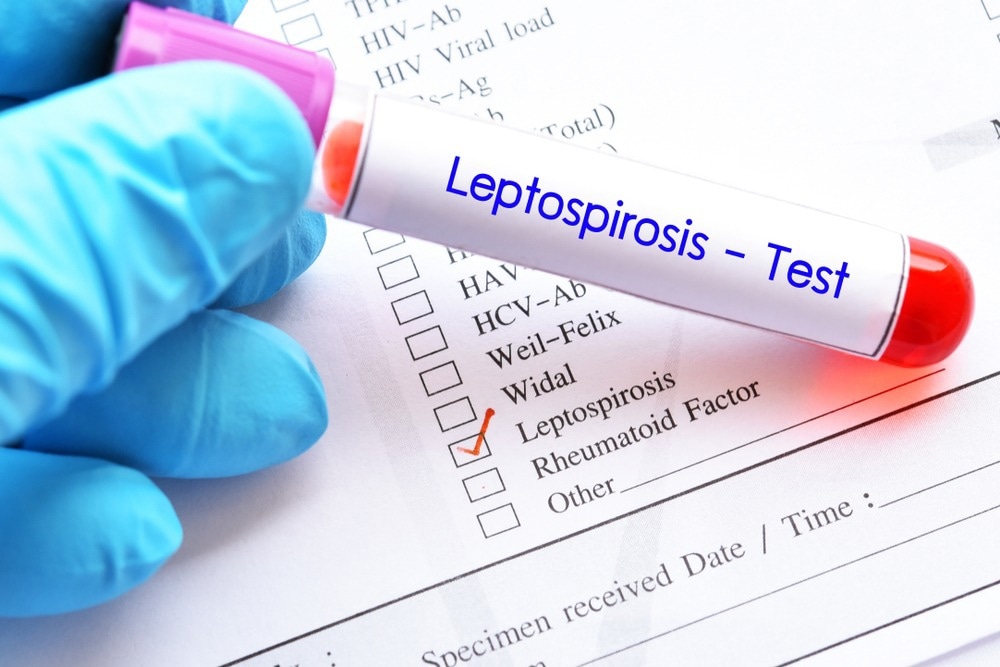Leptospirosis is a bacterial disease infecting both humans and animals. This zoonotic disease is most prevalent in tropical countries. In a recent ACS Applied Nano Materials study, researchers demonstrated the fabrication of an immunosensor that can rapidly and accurately detect leptospira in clinical samples.

Study: Au Nanoparticle-Based Disposable Electrochemical Sensor for Detection of Leptospirosis in Clinical Samples. Image Credit: Jarun Ontakrai/Shutterstock.com
This disposable immunosensor has been developed using gold nanoparticle (AuNp)-modified paper electrodes (PPEs) along with carbon nanotube (CNT) labeled with monoclonal anti-LipL32 (e-LipL32).
What Do We Know About Leptospirosis?
Among zoonotic diseases, leptospirosis is one of the leading causes of global morbidity and mortality, with approximately 1.03 million cases being reported every year. This disease is common in resource-limited populations, specifically in low to middle-income countries. The global impact of leptospirosis is not well understood because it is one of those diseases that has been neglected globally.
Leptospirosis is caused by pathogenic spirochetes belonging to the genus Leptospira. It is extremely difficult to differentiate between pathogenic spirochetes species from non-pathogenic ones based on morphologic and biochemical characteristics.
Some common factors that lead to the worldwide spread of leptospirosis are climate change, globalization, and a wide range of mammalian hosts. Leptospirosis is often misdiagnosed due to several non-specific symptoms. Hence, there is a need for a more accurate diagnostic method to help in the early diagnosis, so suitable treatment can start immediately.
The available diagnostic methods for leptospirosis lack accuracy, sensitivity, portability, and repeatability. Mostly, for the clinical diagnosis of the disease, macroscopic agglutination test (MAT), conventional polymerase chain reaction (PCR), culture test, IgM enzyme-linked immunosorbent assay (ELISA), high-resolution melting (HRM) analysis, and real-time PCR (RT-PCR) are used.
Among these methods, MAT is considered to be the gold standard for leptospirosis diagnosis. Nevertheless, this method is time-consuming, requires rare instruments, maintenance of several live cultures, skilled personnel, and is restricted to specific laboratories. For early detection and management of leptospirosis, it is essential to develop a new sensitive, cost-effective, rapid, and user-friendly detection system.
Nano-Based Electrochemical Immunosensor for Leptospirosis Diagnosis
Recently, a highly sensitive, selective, and disposable electrochemical sensor based on gold nanoparticles has been developed to detect leptospirosis in serum samples. For the fabrication of e-LipL32 on disposable AuNp-modified PPEs, a sandwich-type electrochemical immunoassay was applied by combining LipL32, anti-LipL32, and carbon-nanotube-tagged anti-LipL32 (CNT-Ab).
AuNp rendered a significant enhancement of electron transfer rate and also assisted in the immobilization of specific molecules for the fabricated immunosensor. Glutathione (GSH) was used to promote the formation of an elaborately ordered self-assembled monolayer (SAM) on the AuNp, via the S−Au covalent bond. SAMs of GSH enabled the addition of a suitable amount of carboxylic acid (functional group) as well as monoclonal antiLipL32 immobilization. The biological activity of the immobilized proteins was preserved by SAMs.
A better immunorecognition was facilitated by the presence of the CNT label, which acted as a signal enhancer by increasing the electron transfer rate. Hence, the CNT label enhanced the selectivity and sensitivity of the eLipL32 immunosensor.
Analytical techniques, such as X-Ray photoelectron spectroscopy (XPS) analysis and scanning electron microscopy (SEM), were used to validate the successful fabrication of the e-LipL32 sensor. Surface morphological studies confirmed the immobilization of GSH and mAb onto PPE-Au.
GSH concentration and the time required to form SAMs of GSH onto the AuNp-based electrode surface were optimized. Ten mM GSH was selected as the optimal concentration because it exhibited maximum redox potential due to the electrostatic interaction of the carboxyl group of GSH with the cationic probe. As the best oxidation current response was obtained at 10−6 g/mL antibody, this was selected to be the optimal antibody concentration for fabricating the new e-LipL32 sensor.
Importantly, the disposable e-LipL32 sensor exhibited higher sensitivity to LipL32, with the maximum detection limit estimated to be 1 μg/mL and the lower detection limit was found to be 348 fg/mL. Additionally, this electrochemical immunosensor showed excellent selectivity, reproducibility, and acceptable long-term stability.
Clinical Validation of the Immunosensor
For the clinical validation of the e-LipL32 sensor, 20 serum samples of individuals who were suspected of leptospirosis and other febrile illnesses were used. The clinical samples from febrile illness patients exhibited a small increase in current, while leptospirosis samples showed a significant intensification in the peak current, almost by three folds. This finding indicated the high specificity of the e-LipL32 immunosensor towards LipL32 protein present in the clinical samples. The newly developed AuNp-based immunosensor was able to detect LipL32 in clinical samples within 60 minutes.
To further confirm the detection efficacy of the e-LipL32 sensor, the results of the tested clinical samples were compared with gold standard MAT, the IgM spot test, and IgM ELISA. Further, to differentiate the positive diagnosis of leptospirosis from other diseases, a boxplot was computed based on the averaged peak currents of all the clinical samples. A current above 9.8 μA was determined to be the threshold for positive leptospirosis diagnosis, which was confirmed by the MAT test.
To conclude, the e-Lip32 sensor can be used to accurately detect leptospirosis, at its early stage of infection, in both resource-rich and limited conditions.
Reference
Kannan, S. et al. (2022) Au Nanoparticle-Based Disposable Electrochemical Sensor for Detection of Leptospirosis in Clinical Samples. ACS Applied Nano Materials. https://doi.org/10.1021/acsanm.2c01978
Disclaimer: The views expressed here are those of the author expressed in their private capacity and do not necessarily represent the views of AZoM.com Limited T/A AZoNetwork the owner and operator of this website. This disclaimer forms part of the Terms and conditions of use of this website.